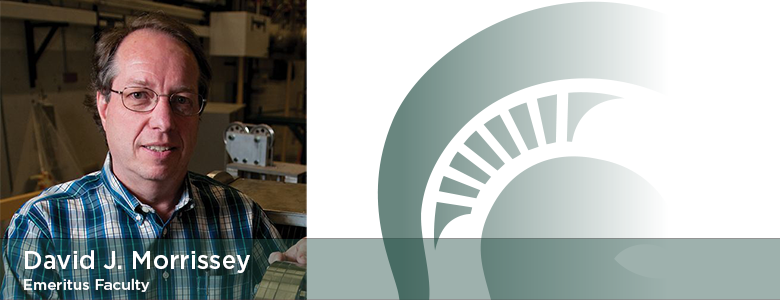David Morrissey

Research
Nuclear Chemistry
Research in nuclear chemistry that is centered on the production and use of the most exotic, short-lived nuclei. We routinely apply this knowledge to produce beams of very exotic radioactive ions. These short-lived nuclei are interesting in their own right, some of which have not been observed before. My graduate students work on unraveling the mechanisms of nuclear reactions, on studying the decay properties of the most exotic nuclei, or on developing new techniques to separate, capture and control fast ions. The NSCL is a unique facility that brings together a strong group of nuclear scientists and provides an exceptional setting for studying the properties of nuclei right on the MSU campus. The cyclotrons accelerate ions that span the periodic table to very high kinetic energies. When the fast ions react with a target nucleus, the incident ion is often broken into nuclear fragments with a distribution of sizes, some of which are very unstable and quite unusual. The probability distributions of the products were early subjects of study by my group and can be predicted with reasonable accuracy. We also showed that the momenta, or velocities, of the fragments are distributed around that of the beam and can be predicted by models of the nuclear reaction. These fast moving fragments can be passed through an isotope separator to produce beams of individual radioactive ions. We help to design and develop these fragment separators, which have become the central instruments for research at the NSCL and the Facility for Rare Ion Beams (FRIB) under construction at MSU. The NSCL currently relies on its second generation fragment separator completed in 2001 while a revolutionary new fragment separator is being designed for the FRIB facility that will replace the NSCL.
Along with using the new fragment separator for production and decay studies, our group has completed the construction and development of an auxiliary device to slow down the exotic reaction products to thermal energies. In this project, we have extended the ionguide ion-source (IGISOL) technique to collect individual radioactive ions. A helium-filled chamber is tailored to stop and collect the exotic isotopes produced by the A1900 fragment separator at NSCL using a differentially pumped gas-filled cell in a process related to atmospheric-sampling mass spectrometry. The so-called gas-catcher system was used in many successful and extremely precise mass measurements at the NSCL carried out by the group headed by Prof. Bollen (MSU Physics). More recently the thermalized ions were used in collinear laser spectroscopy experiments, precision decay studies, and nuclear reaction studies. We are currently constructing a next-generation device for thermalization of projectile fragments based on the concept of a reverse cyclotron that will be able to provide the large variety of fragments needed for mass measurements and other new experiments at the NSCL. The cyclotron-stopper is based on a four meter diameter superconducting magnet that weighs approximately 200 tons (see below).
